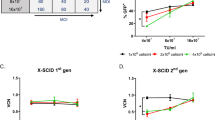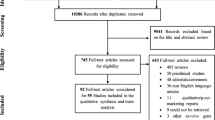Abstract
Haematopoietic stem cell transplantation (HSCT) is now widely used to treat primary immunodeficiencies (PID). For patients with specific disorders (severe combined immunodeficiency (SCID)-X1, adenosine deaminase deficiency (ADA)–SCID, X-chronic granulomatous disease (CGD) and Wiskott–Aldrich Syndrome (WAS)) who lack a suitable human leukocyte antigen (HLA)-matched donor, gene therapy has offered an important alternative treatment option. The success of gene therapy can be attributed, in part, to the selective advantage offered to gene-corrected cells, the avoidance of graft-versus-host disease and to the use of pre-conditioning in patients with chemotherapy to facilitate engraftment of corrected cells. Adverse events have been encountered and this has led to detailed characterization of retroviral vector integration profiles. A new generation of self-inactivating retroviral and lentiviral vectors have been designed to address these safety concerns, and are at an advanced stage of preparation for the next phase of clinical testing.
This is a preview of subscription content, access via your institution
Access options
Subscribe to this journal
Receive 12 print issues and online access
$259.00 per year
only $21.58 per issue
Buy this article
- Purchase on Springer Link
- Instant access to full article PDF
Prices may be subject to local taxes which are calculated during checkout

Similar content being viewed by others
References
Wada T, Candotti F . Somatic mosaicism in primary immune deficiencies. Curr Opin Allergy Clin Immunol 2008; 8: 510–514.
Cavazzana-Calvo M, Carlier F, Le Deist F, Morillon E, Taupin P, Gautier D et al. Long-term T-cell reconstitution after hematopoietic stem-cell transplantation in primary T-cell-immunodeficient patients is associated with myeloid chimerism and possibly the primary disease phenotype. Blood 2007; 109: 4575–4581.
Howe SJ, Mansour MR, Schwarzwaelder K, Bartholomae C, Hubank M, Kempski H et al. Insertional mutagenesis combined with acquired somatic mutations causes leukemogenesis following gene therapy of SCID-X1 patients. J Clin Invest 2008; 118: 3143–3150.
Hacein-Bey-Abina S, Garrigue A, Wang GP, Soulier J, Lim A, Morillon E et al. Insertional oncogenesis in 4 patients after retrovirus-mediated gene therapy of SCID-X1. J Clin Invest 2008; 118: 3132–3142.
Deichmann A, Hacein-Bey-Abina S, Schmidt M, Garrigue A, Brugman MH, Hu J et al. Vector integration is nonrandom and clustered and influences the fate of lymphopoiesis in SCID-X1 gene therapy. J Clin Invest 2007; 117: 2225–2232.
Schwarzwaelder K, Howe SJ, Schmidt M, Brugman MH, Deichmann A, Glimm H et al. Gammaretrovirus-mediated correction of SCID-X1 is associated with skewed vector integration site distribution in vivo. J Clin Invest 2007; 117: 2241–2249.
Cavazzana-Calvo M, Fischer A . Gene therapy for severe combined immunodeficiency: are we there yet? J Clin Invest 2007; 117: 1456–1465.
Chinen J, Davis J, De Ravin SS, Hay BN, Hsu AP, Linton GF et al. Gene therapy improves immune function in preadolescents with X-linked severe combined immunodeficiency. Blood 2007; 110: 67–73.
Carbonaro DA, Jin X, Cotoi D, Mi T, Yu XJ, Skelton DC et al. Neonatal bone marrow transplantation of ADA-deficient SCID mice results in immunologic reconstitution despite low levels of engraftment and an absence of selective donor T lymphoid expansion. Blood 2008; 111: 5745–5754.
Engel BC, Podsakoff GM, Ireland JL, Smogorzewska EM, Carbonaro DA, Wilson K et al. Prolonged pancytopenia in a gene therapy patient with ADA-deficient SCID and trisomy 8 mosaicism: a case report. Blood 2007; 109: 503–506.
Sokolic R, Kesserwan C, Candotti F . Recent advances in gene therapy for severe congenital immunodeficiency diseases. Curr Opin Hematol 2008; 15: 375–380.
Aiuti A, Cassani B, Andolfi G, Mirolo M, Biasco L, Recchia A et al. Multilineage hematopoietic reconstitution without clonal selection in ADA–SCID patients treated with stem cell gene therapy. J Clin Invest 2007; 117: 2233–2240.
Stein S, Ott MG, Schultze-Strasser S, Jauch A, Burwinkel B, Schmidt M et al. Gene therapy for chronic granulomatous disease: current status of the German clinical study. Human Gene Ther 2008; 19: 1097.
Kim JG, Ahn HS, Kang HJ, Kim S, Hong YT, Joo CW et al. Retroviral gene therapy for X-linked chronic granulomatous disease: results from phase I/II trial. Blood 2008; 112: 818.
Malech HL, Linton GF, Whiting-Theobald N, Naumann N, De Ravin SS, Choi U et al. Update on gene therapy for chronic granulomatous disease: current studies and future approaches. Blood Cells Mol Dis 2008; 40: 274–275.
Boztug K, Dewey RA, Diez IA, Manfred S, Kerstin S, Jana D et al. Hematopoietic stem cell gene therapy for Wiskott–Aldrich Syndrome. Blood 2007; 110: 155A.
Benjelloun F, Garrigue A, Demerens-de Chappedelaine C, Soulas-Sprauel P, Malassis-Seris M, Stockholm D et al. Stable and functional lymphoid reconstitution in artemis-deficient mice following lentiviral artemis gene transfer into hematopoietic stem cells. Mol Ther 2008; 16: 1490–1499.
Bauer Jr TR, Allen JM, Hai M, Tuschong LM, Khan IF, Olson EM et al. Successful treatment of canine leukocyte adhesion deficiency by foamy virus vectors. Nat Med 2008; 14: 93–97.
Qasim W, Cavazzana-Calvo M, Davies EG, Davis J, Duval M, Eames G et al. Allogeneic hematopoietic stem-cell transplantation for leukocyte adhesion deficiency. Pediatrics 2009; 123: 836–840.
Zychlinski D, Schambach A, Modlich U, Maetzig T, Meyer J, Grassman E et al. Physiological promoters reduce the genotoxic risk of integrating gene vectors. Mol Ther 2008; 16: 718–725.
Schambach A, Baum C . Vector design for expression of O6-methylguanine–DNA methyltransferase in hematopoietic cells. DNA Repair (Amst) 2007; 6: 1187–1196.
Thornhill SI, Schambach A, Howe SJ, Ulaganathan M, Grassman E, Williams D et al. Self-inactivating gammaretroviral vectors for gene therapy of X-linked severe combined immunodeficiency. Mol Ther 2008; 16: 590–598.
Zhou S, Greene M, Lu T, Shou Y, Sorrentino BP . Development of effective and safe lentiviral vectors for the treatment of X-linked severe combined immunodeficiency. Blood Cells Mol Dis 2008; 40: 285.
Modlich U, Navarro S, Zychlinski D, Maetzig T, Knoess S, Brugman MH et al. Insertional transformation of hematopoietic cells by self-inactivating lentiviral and gammaretroviral vectors. Mol Ther 2009 (e-pub ahead of print 11 August 2009).
Cavazzana-Calvo M, Cartier N, Abina SHB, Veres G, Schmidt M, Bartholomae C et al. Hematopoietic stem cell gene therapy trial with lentiviral vector in X-linked adrenoleukodystrophy. Blood 2008; 112: 304–305.
Lombardo A, Genovese P, Beausejour CM, Colleoni S, Lee YL, Kim KA et al. Gene editing in human stem cells using zinc finger nucleases and integrase-defective lentiviral vector delivery. Nat Biotechnol 2007; 25: 1298–1306.
Paques F, Duchateau P . Meganucleases and DNA double-strand break-induced recombination: perspectives for gene therapy. Curr Gene Ther 2007; 7: 49–66.
Redondo P, Prieto J, Munoz IG, Alibes A, Stricher F, Serrano L et al. Molecular basis of xeroderma pigmentosum group C DNA recognition by engineered meganucleases. Nature 2008; 456: 107–111.
Author information
Authors and Affiliations
Corresponding author
Rights and permissions
About this article
Cite this article
Qasim, W., Gaspar, H. & Thrasher, A. Progress and prospects: gene therapy for inherited immunodeficiencies. Gene Ther 16, 1285–1291 (2009). https://doi.org/10.1038/gt.2009.127
Received:
Accepted:
Published:
Issue Date:
DOI: https://doi.org/10.1038/gt.2009.127
Keywords
This article is cited by
-
Effective gene delivery based on facilely synthesized “core–shell” Ag@PDA@PEI nanoparticles
Journal of Nanoparticle Research (2022)
-
Zinc-finger nuclease-mediated gene correction using single AAV vector transduction and enhancement by Food and Drug Administration-approved drugs
Gene Therapy (2013)
-
Lentiviral Vector Induced Insertional Haploinsufficiency of Ebf1 Causes Murine Leukemia
Molecular Therapy (2012)
-
A combined approach for β-thalassemia based on gene therapy-mediated adult hemoglobin (HbA) production and fetal hemoglobin (HbF) induction
Annals of Hematology (2012)
-
Gene Therapy of Chronic Granulomatous Disease: The Engraftment Dilemma
Molecular Therapy (2011)



